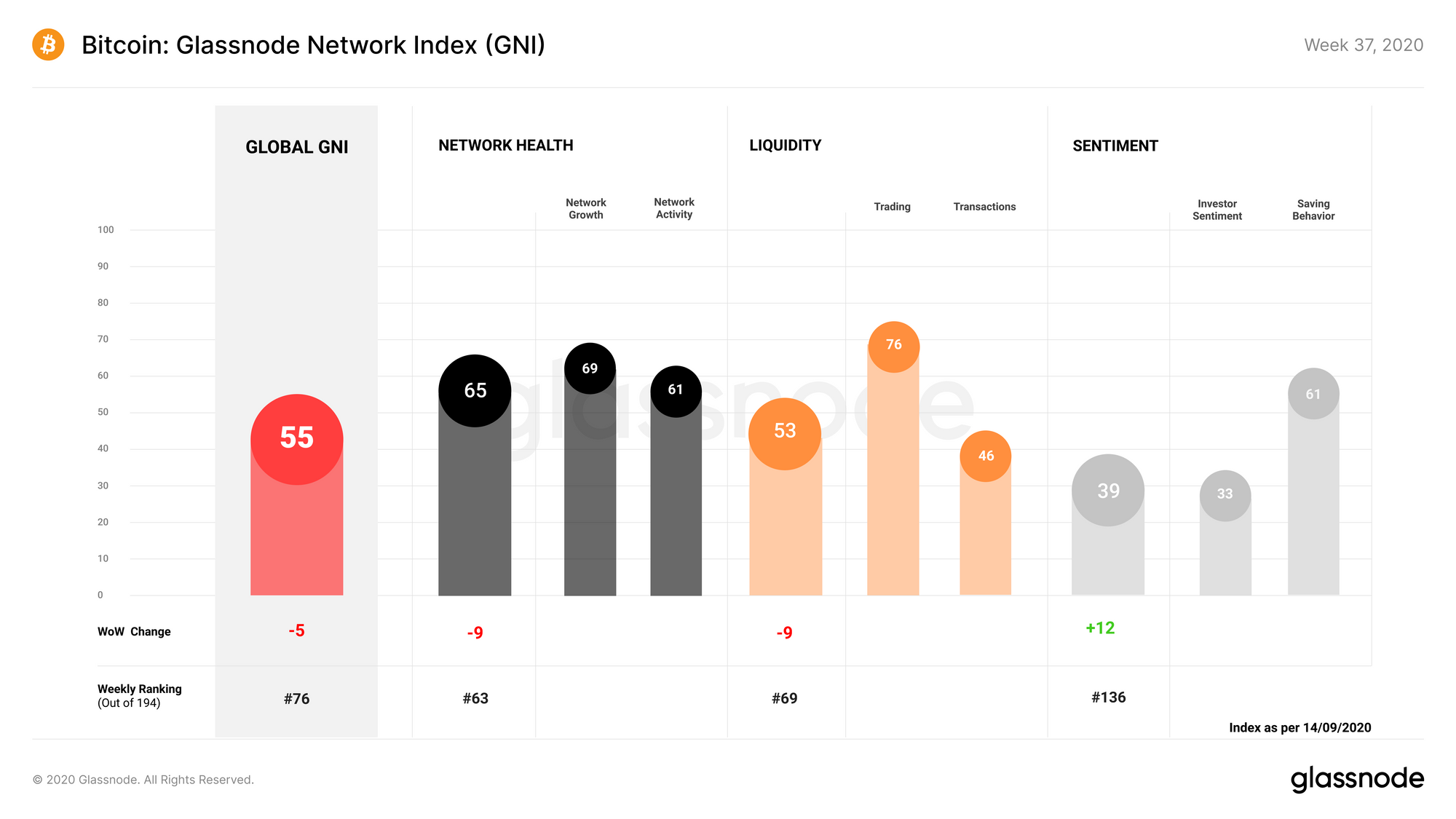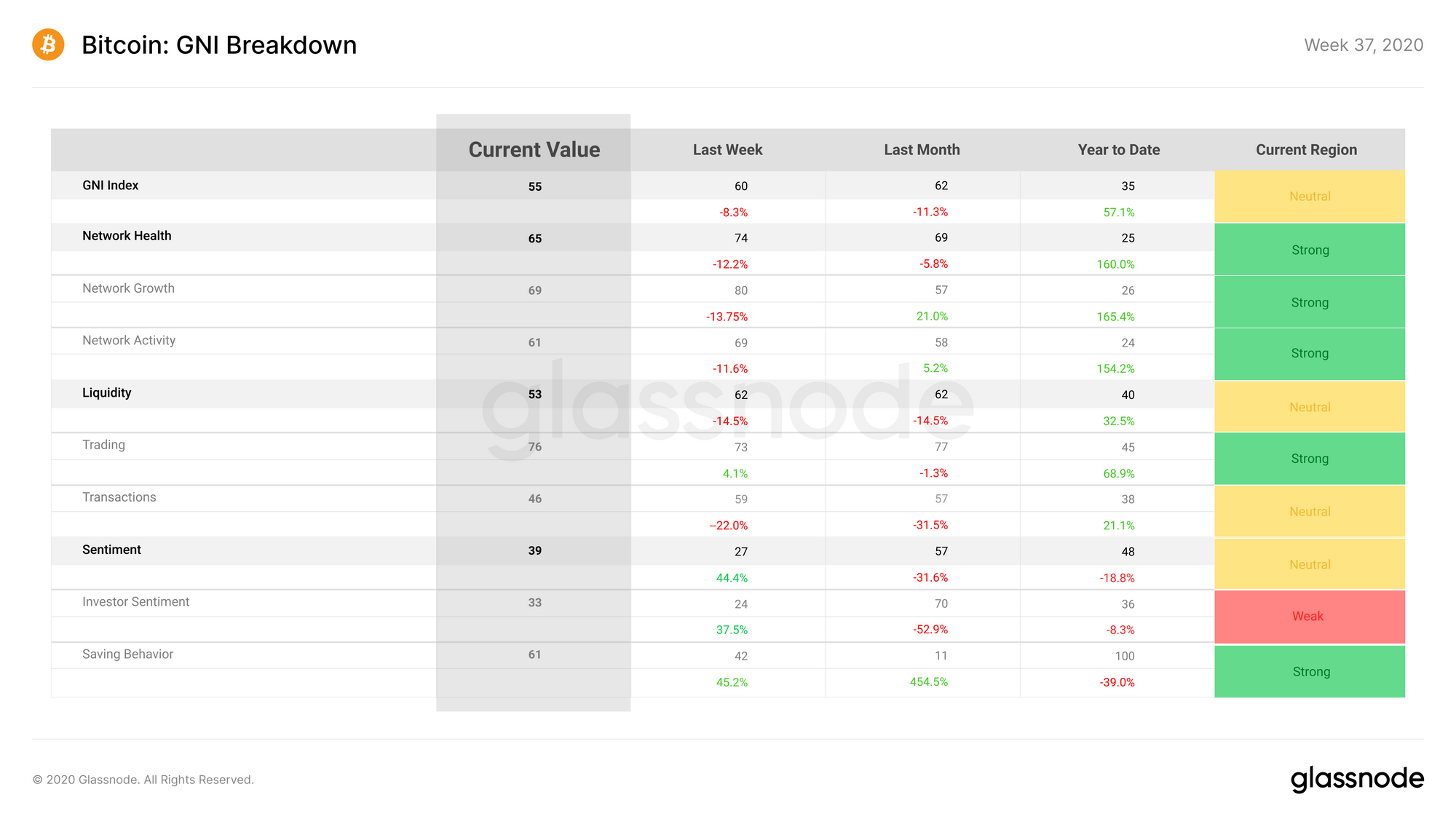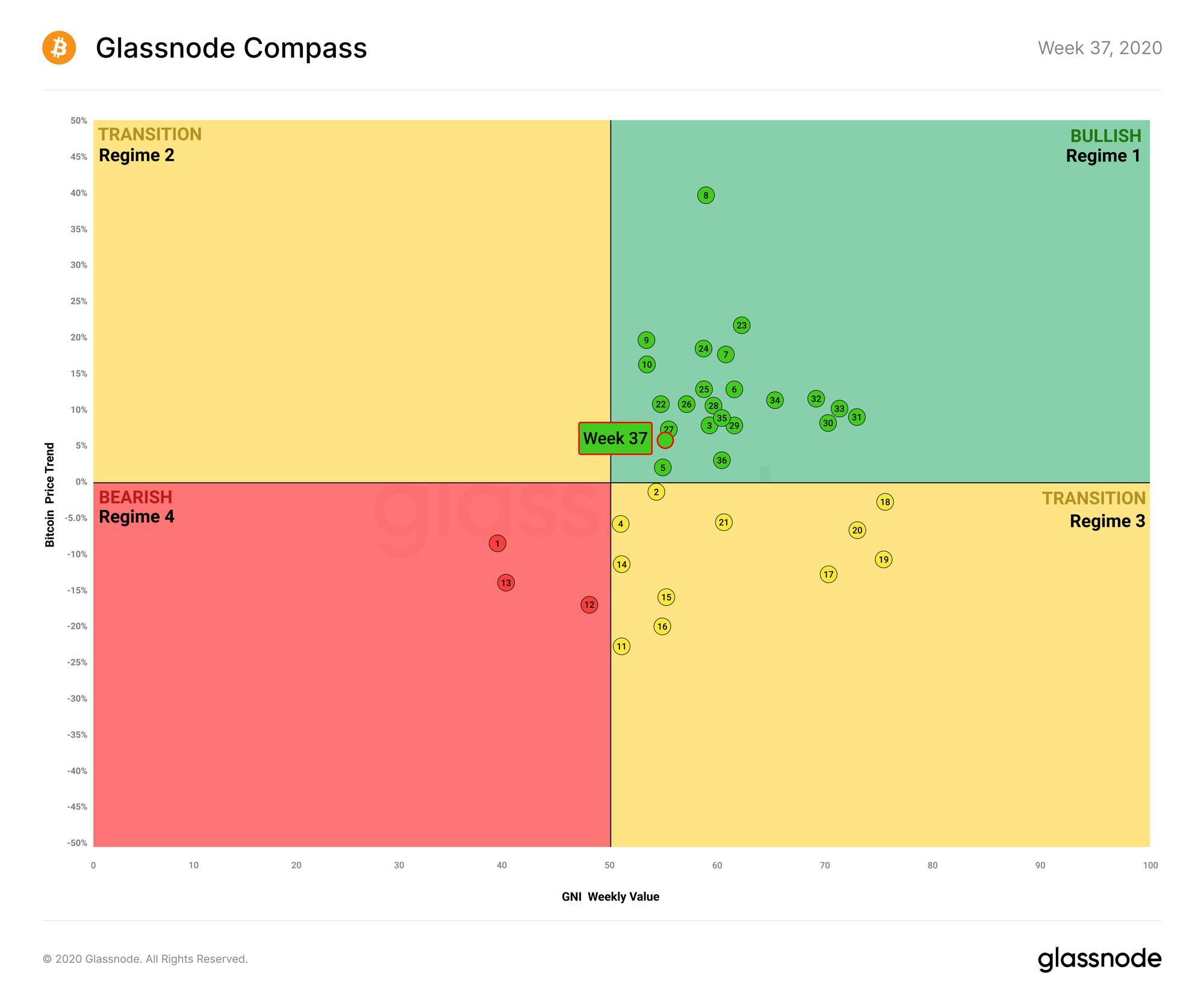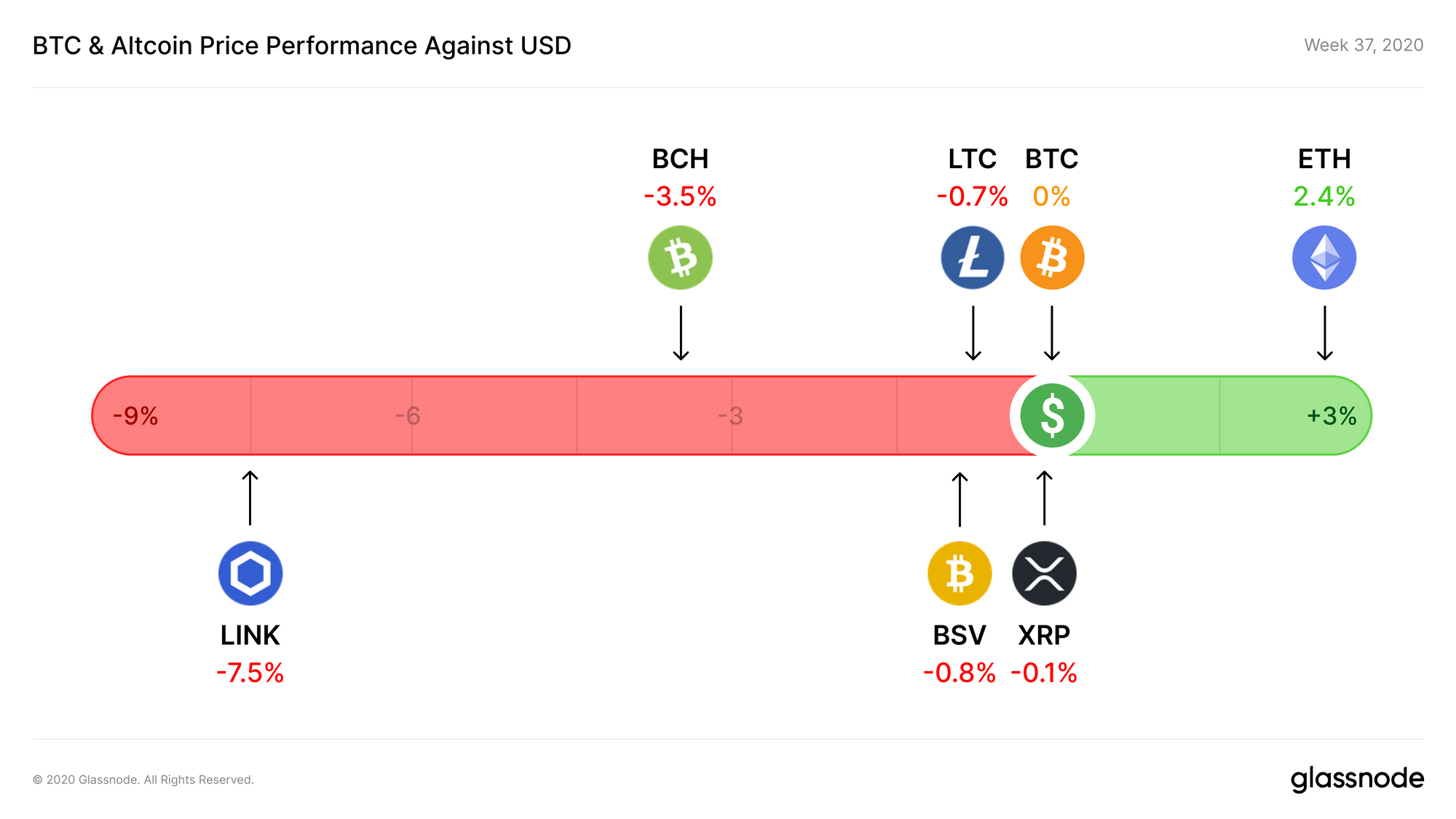The Week On-Chain (Week 37, 2020)
Bitcoin's on-chain fundamentals are slipping slowly as its price stagnates around $10k. Meanwhile, activity within the Ethereum ecosystem is continually picking up.

Bitcoin Market Health
Bitcoin had yet another stable week throughout Week 37, starting out on Monday morning at $10,340 and ending at the same value. Throughout the week, it fluctuated in a range of about $600, but stayed mostly consistent.

Bitcoin on-chain fundamentals decreased yet again throughout Week 37. GNI lost another 5 points, taking it down to a score of 55. The Network Health and Liquidity subindices both lost 9 points, while Sentiment slowed the decline, gaining 12 points.

Network Health stayed in the strong zone with 65 points for Week 37, but still saw a significant 9 point decrease from the previous week. Network growth and network activity both took hits as on-chain transactions slowed down and fewer new users joined the network.
Liquidity also lost 9 points, taking it into the neutral zone at a total of 53 points. While trading liquidity improved throughout the week, the transaction liquidity subcategory lost 13 points amidst the decrease in on-chain activity.
Sentiment slowed the decline in on-chain fundamentals by gaining 12 points over Week 37, reaching a score of 39. Both the investor sentiment and saving behavior subcategories increased. The rate at which hodlers have been acquiring BTC increased, likely due to lower prices, while bitcoin's stability above $10k likely contributed to positive sentiment, despite a lack of upward price movement.

Glassnode Compass
Week 37 saw the bitcoin compass stay in Regime 1 for the 16th week in a row, marking four continued months of bullish fundamentals, both in terms of on-chain activity and price trends.

While GNI decreased by 5 points over the week, bitcoin's price trend improved slightly, keeping the compass in the green zone. However, despite sustained strength in BTC's on-chain fundamentals, it has trended closer to the center of the compass over the past few weeks as the network begins to see some stagnation.
Meanwhile, BTC is losing market dominance as DeFi protocols on Ethereum continue to see rapid growth. A similar trend played out in the bull run of early 2017, when money flowed into high-yield ICOs at a much faster rate than BTC. However, later in 2017, BTC started to regain dominance as ICO investors took profits and de-risked into a more reputable asset.
The question for this bull market is whether investors will move profits from high-yield DeFi tokens into BTC, or into another asset such as ETH or stablecoins. Many investors now talk of "stacking wei" as opposed to "stacking sats", signifying a potential shift in BTC's status as the default store of value within crypto markets.
As the Bitcoin and Ethereum communities increasingly diverge in their philosophy and demographics, BTC stands more of a chance of attracting investment from traditional hedge funds than the DeFi community.
Altcoin Digest
Performance against BTC
Throughout Week 37, the top altcoins mostly stayed within close range of BTC. The biggest gainer against bitcoin was ETH, up 2.4% for the week, while LINK lost 7.4% of its value next to BTC.

LINK's performance over the past few weeks has taken it down from 5th to 8th place in terms of market cap, seeing it overtaken by BNB, DOT, and BCH.
Performance against USD
Because of bitcoin's stable price throughout the week, the top altcoins' performance against USD was about the same as against BTC.

Once again, ETH was the biggest winner, while LINK lost the most value of all major altcoins, dropping by 7.5%.
Which altcoins would you like to see us cover in future editions of The Week On-Chain? Let us know on Twitter, or enter our latest survey competition to have your say.
Over 15% of ETH is Locked in Smart Contracts
With the rise of DeFi protocols - especially those which offer yield farming and liquidity mining - the utility of ETH has never been higher. Rather than passively holding, investors are locking up their ETH in all kinds of smart contracts in order to generate returns.
As a result, over 15% of all ETH is locked in smart contracts on Ethereum right now - up from 11.5% a year ago.

Over 5% of ETH is locked up in the WETH (wrapped ether) smart contract, enabling it to interact with other tokens more easily. Most of this WETH has then been locked up in DeFi contracts, including Maker, Uniswap, and Balancer. Aside from DeFi use cases via WETH, the largest ETH balances in smart contracts are for exchange multisigs (e.g. Bitfinex and Gemini) and Compound's ETH pool.
While exchange multisigs simply represent custodial passive holding, the other contracts (WETH, Compound, etc.) are all examples of how ETH is moving beyond the simple "store of value" use case.
The growing presence of ETH in these contracts represents its increasing utility - as a currency, a hedge, and a schelling point for liquidity provision.
Competition
Win a free Advanced subscription to Glassnode Studio for a year

We want to make Glassnode Studio as useful and feature-rich as possible for our users. To that end, we have created a short survey to get your feedback.
Complete the survey and be in to win a free Advanced subscription to Glassnode Studio for a year. The winner will be informed via email on 15 September.
➡ Enter now to win
Product Updates
Metrics and Assets
- Exchange Fees (BTC, ETH) - The total amount of fees paid in transactions related to on-chain exchange activity, broken down by transaction type. New metrics: Total Exchange Fees, Mean Exchange Fees, Exchange Fee Dominance.

- Follow us and reach out on Twitter
- Join our Telegram channel
- For on–chain metrics and activity graphs, visit Glassnode Studio
- For automated alerts on core on–chain metrics and activity on exchanges, visit our Glassnode Alerts Twitter
